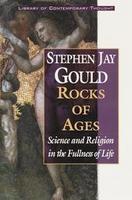 | |
| Author | Stephen Jay Gould |
|---|---|
| Subject | Relationship between religion and science |
| Publisher | Ballantine Books |
Publication date | 1999 |
| Media type | |
| Pages | 256 |
| ISBN | 0-345-43009-3 |
| OCLC | 39886951 |
| 291.1/75 21 | |
| LC Class | BL240.2 .G68 1999 |
| Preceded by | Leonardo's Mountain of Clams and the Diet of Worms |
| Followed by | The Lying Stones of Marrakech |
Rocks of Ages: Science and Religion in the Fullness of Life is a 1999 book about the relationship between science and religion by the Harvard paleontologist Stephen Jay Gould. First published by Ballantine Books, it was reprinted by Vintage Books. The book is a volume in the series The Library of Contemporary Thought.